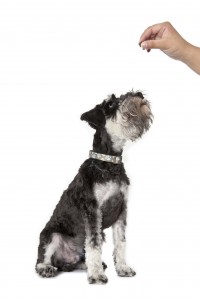 You might have read some of the traditional training books or watched a certain tv show that talks about training with treats as if it were a sloppy or mamby-pamby way to train dogs, whereas training with punishment means the dog works with you because they love you. The people who avoid treats just don’t know enough about *how* to train dogs with treats, and I thought I’d write a blog post to give an overview of how to precisely use reinforcers to get reliable dog behavior.
You might have read some of the traditional training books or watched a certain tv show that talks about training with treats as if it were a sloppy or mamby-pamby way to train dogs, whereas training with punishment means the dog works with you because they love you. The people who avoid treats just don’t know enough about *how* to train dogs with treats, and I thought I’d write a blog post to give an overview of how to precisely use reinforcers to get reliable dog behavior.
First, you get what you pay for. A dog’s behavior is only as strong as the perceived reward or punishment. Does that mean we have to have a treat present to get the dog to work? Of course not. They just need a strong reinforcement (or punishment) history and occasional reminders. I build reinforcement histories. I don’t care for using aversives to punish, as I don’t think that’s necessary.
That means that when you train your dog with reinforcers (treats, toys, play, praise, petting), you need to make sure the reinforcer is valuable to the dog at that moment. At home, regular dog food is a great way to train your dog. In dog training classes, they’ll need “hazard pay” to compete with distractions, like meaty treats mixed in with some kibble. You can put visual barriers around your dog to decrease distractions if you want to use more boring treats. Or you can make sure your dog is very hungry – no lunch or dinner for an evening class. If you’re worried about your dog’s digestive system, boiled chicken is usually very easy on a dog’s belly; vets have dogs go on diets of chicken and rice if they have loose stool.
You can spice up your dog’s kibble by putting it in a container with some other kind of treat. Add a little water and some parmesan cheese and let it sit over night. Or mix in some low-fat organic hot dogs and let them soak up the flavor. You may even be able to get away with just feeding the kibble and tossing the hot tdogs.
Second, don’t mix methods. When you use reinforcement, it’s better to not mix that with punishment. Studies say that adding punishment weakens the value of training with reinforcement (one source: University of North Texas “Poisoned Cue” study). It’s not just that I’m a nice person (though I am!). I don’t use leash corrections or push dogs into position if they don’t listen because it’s not, scientifically, the right thing to do. I don’t want to waste my training time. My life is busy enough as it is!
Alternate that with getting treats out and being obvious about it. Have the dog do something and then praise, pet, play, but don’t treat. You’re basically letting them know that the presence of food is irrelevant to whether they’ll get some food or not.
Train your dog with toys in the same way. It’s a good idea to get a small tug toy that you can hide in your pocket. After your dog responds to sit, heel, come, etc., whip out the toy and play! (Watch the Rules for Tug with your dog video.)
As the dog gets more capable, you will start to give big rewards 2 out of 3 times, for the best responses, then gradually only if the behavior is somehow Better Than Average. Don’t wean off of tangible rewards too quickly, but do it gradually so that your dog is still addicted to working for you. As you move away from tangible rewards, keep rewarding sometimes in other ways – permission to go out the door, permission to pee on a bush, permission to go into the park or chase a squirrel, etc.
**********
What if your dog won’t sit? For one thing, that may just mean you haven’t practiced in this environment or they don’t know the Sit cue well enough. You might have moved your body differently than you normally do, or there’s a particularly interesting smell across the room. If you want to give the benefit of the doubt, give your dog a 5 second break and then re-teach the sit in that new location. Use at most 3 lures before switching back to “sit” + “hand signal” + treat after response.
If you feel like your dog really does know the behavior, but isn’t doing it (because you’ve practiced in a lot of different places, and a lot of different ways) you can just make her bored until she responds (a light grab on the collar, so she doesn’t leave) or you can give your dog a hand signal or lure the sit. But then DON’T give the treat, because the dog’s sit was worse than average. Just release the dog (“okay”) and walk or turn away. If he comes back up to you, ask for a sit again and if she does it, give her a reward (food treat or toy, plus praise).
Dogs can be trained to be extremely reliable using positive reinforcement. Don’t hurt your training program by relying on force or corrections. Just make sure to remember to reward only above-average behavior. After all, You Get What You Pay For!